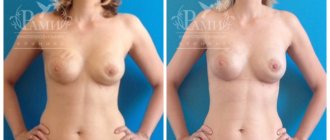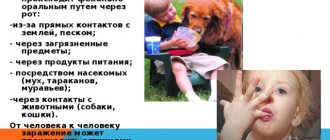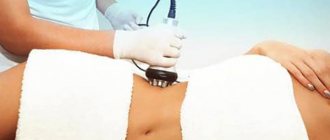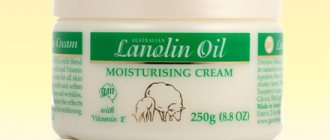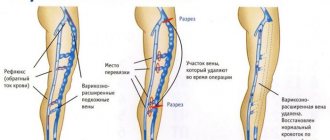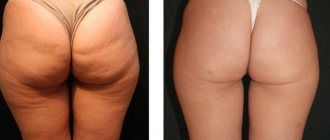What it is?
Lipofilling (from the Greek “lipos” - fat, “filing” - to fill) is a correction of facial and body contours, the essence of which is to transplant the patient’s fat tissue from one area of the body to another.
In fact, this is not the kind of operation that people usually imagine. Fat grafting is a series of special injections . They can be performed without resorting to anesthesia, only under local anesthesia. First, fat is directly collected using a blunt-nosed needle from the fatty tissue of the abdomen or inner thigh. These areas contain the necessary and most useful material for rejuvenation, since it has the most suitable structure for transplantation and contains many stem cells.
After this, the fat goes through several stages of purification. It is then filled into syringes and injected into the desired area. Plastic surgeons and cosmetologists perform lipofilling.
Below is an informative video about lipofilling:
The lipofilling procedure has certain features depending on the area where it is performed. Read about lipofilling of the buttocks, nasolabial folds, lips, arms and intimate areas, lower and upper eyelids, cheekbones, chin, neck and nasolacrimal groove, mammary glands, as well as legs and calf muscles.
Photos before and after
In the photo below you can see what the face looks like before and after the procedure.
Results of the procedure
In the photographs above you can see the positive result after lipofilling. The face looks much younger and fresher. Sunken cheekbones have become plumper, tear grooves are less noticeable, the skin is elastic and healthy.
You can notice that after lipofilling, nasolabial wrinkles smoothed out, and visually the lips began to look healthier and plumper . In general, the result was positive, the patient began to look much younger and more beautiful. It is important that correction of a specific area of the face gives excellent results for the entire face as a whole.
Advantages
Today, the procedure is becoming more and more popular (mainly among older people for rejuvenation purposes, but sometimes for medical reasons), since it is a relatively safe operation.
- Since the patient's own fat cells are used for lipofilling, it does not cause any allergies or tissue rejection. Therefore, the transplant is carried out practically without preliminary consultations, which saves the patient’s time and money (but before lipofilling you will still have to donate blood for some tests).
- The resulting result looks as natural as possible in comparison with other plastic surgery options.
Why complications occur during eyelid lipofilling and how to avoid them
Work on the eyelid lipofilling method in order to obtain an “ideal” result is still ongoing. Such a feature as the unpredictability of the engraftment of fat autograft is not so significant today. But we pay special attention to the issue of the volume of one-time injection of fat.
World expert in the field of lipofilling, Doctor of Medical Sciences David Rubenovich Grishkyan says:
“Why do I consider this question to be the main one in obtaining the desired result in rejuvenating the lower eyelids? The widespread use of eyelid lipofling as a method of rejuvenating the periorbital area is hampered by the imperfection of the technology for introducing fatty autograft. It is known that the relative, at first glance, simplicity of the technique can play a “wicked joke” on the surgeon, leading to complications. But the complication of lipofilling can only be corrected surgically. »
Fat injection techniques for eyelid lipofilling
As a rule, when carrying out lipofilling, two main techniques are used. The first is the so-called “spraying” method. With this method, a small amount of fat is injected into a specific area using dozens of small strokes.
The second technique is the linear insertion technique. In our opinion, the first technique has a number of disadvantages. – Numerous movements of the cannula cause tissue injury. – Tissue swelling may interfere with the analysis of the results obtained. – It is difficult to control the volume of injection, especially if the surgeon does not have sufficient experience in performing the operation. – As a rule, the introduction of fat with this technique occurs when the cannula moves forward, which is fraught with complications. In his daily practice, surgeon D.R. Grishkyan uses the technique of slow retrograde linear injection of fat autograft. This technique allows you to carefully control the volume, layers and area of fat injection, avoiding overcorrection and vascular injury.
Multi-layering as a principle for introducing fat
The next point is the principle of introducing fat. An important factor is layering. We do not inject fat like a regular filler, but place the graft layer by layer according to the principle of building a pyramid. In this case, it is important from which layer to start adding fat. As a rule, we begin the introduction from the deep layers and then move higher to the skin. However, in some cases it is recommended to start the introduction from the superficial layers. The main choice of layer is the thickness of the leather.
Volume of administration
To correct the periorbital area, we introduce the volume of fat implant that we consider necessary. But the main thing that needs to be taken into account when mentioning the volume of injected fat is the size of the fat autograft . In our practice, we use fat implants of the smallest possible size, and it was the reduction in the size of the injected fat tissue and the combination of techniques that allowed us to increase the volume of injection, avoiding complications
Flaws
Although the procedure is considered safe and effective, there is still a certain risk of some complications :
The appearance of severe swelling.- Bruises at the sites where fatty tissue is taken and inserted.
- Numbness of the skin in the donor areas (occurs rarely, then quickly disappears).
- Pain syndrome (usually stops soon).
- Asymmetry and unevenness of the skin surface in the area of fat injection. This is a temporary phenomenon that goes away after the swelling subsides and the excess injected fat is absorbed. However, if the form does not recover for more than a few months, then it is worth contacting a specialist.
- Infection (in exceptional cases).
- In very rare cases, complete resorption of the adipose tissue and no effect from the operation. It depends individually on the individual patient’s body.
- Disturbance of pigmentation at the sites of fat injection.
To avoid such consequences, it is recommended to choose a good specialist. It is best to work with an experienced surgeon who approaches his work competently and responsibly, and it is also advisable to review his previous results of operations and procedures.
Do not forget that most of the successful correction depends on the doctor. Plus, following the care and doctor’s instructions after lipofilling is completed plays a big role.
The main question that I always ask myself during consultations with patients who come for eyelid surgery is: what is the problem with this particular patient, does she need eyelid surgery in its standard form? Even if we are talking about fat redistribution according to the De La Plaza method (1981), will this give the desired result?
I consider diagnosing the condition of the lower eyelids, or more precisely the periorbital area, an important part of the consultation. At the same time, I note: we believe that the middle zone, including the periorbital zone, is a complex of interconnected elements. Age-related changes here occur in a certain sequence; they are not isolated from each other. In this regard, we have developed criteria for assessing age-related changes in the midface, according to which we determine the extent of the operation.
Criteria for assessing age-related changes:
1. The presence of excess skin, its quality.
2. Severity of lower eyelid hernias.
3. Expressiveness of the tear trough.
4. Level of projection of the eyelid-buccal groove (height of the lower eyelid).
5. The position of the lateral eye angle in relation to the medial one.
6. Projection of the eyeball to the lower orbital margin.
7. Availability of a painting bag.
8. Projection of cheekbones.
9. Volume of the buccal area.
We consider the most important analysis of the first four points, during which it is necessary to answer the main question: “What is the patient’s problem: the presence of hernial protrusions of the lower eyelids or the presence of a tear trough?”
In my practice, I more often meet patients whose problem is precisely loss of volume rather than ptosis in the area of the lower eyelids and middle zone.
This is not a public offer! There are contraindications. Before use, consultation with a specialist is required.
Let's consider a specific example: a 25-year-old patient with pronounced hernial protrusions of the lower eyelids, elongation of the lower eyelids, a pronounced transition of the eyelid-cheek, eyelid-cheekbone.
This is not a public offer!
There are contraindications. Before use, consultation with a specialist is required. At the same time, there is a slight flattening of the zygomatic and buccal areas.
We decided to use the lipofilling method to correct the midface area, including the lower eyelids, using lipofilling.
This is not a public offer! There are contraindications. Before use, consultation with a specialist is required.
This example clearly shows the possibilities of lipofilling, if used according to indications. Moreover, the result is absolutely stable.
If we talk about standard blepharoplasty in this patient, that is, about the removal of fatty protrusions (in this case we would be talking about transconjunctival blepharoplasty), this would lead to the formation of deep depressions in the infraorbital region, and the bruises under the eyes would increase. With the distribution of fatty protrusions, the situation would be better, but still the fatty bags would not be enough to fill the tear trough and for a smooth transition between the eyelid and cheek. Therefore, to achieve a good result, lipofilling was chosen.
This is not a public offer! There are contraindications. Before use, consultation with a specialist is required.
Swelling after the procedure - causes and prevention
Swelling, unlike all other symptoms accompanying the postoperative condition, manifests itself in any case without exception . The reason lies in the reaction of tissues to injury, inflammation, as well as temporary lymphostasis - a violation of the outflow of fluid from tissues, since when fat is introduced, the volume of the receiving zone greatly increases and pressure occurs on the veins and lymphatic vessels.
Swelling does not appear immediately, but only 24 hours after the procedure and reaches its maximum on the third day. This is due to a decrease in blood flow in the operation area (by about half). But from day 5 the swelling begins to resolve and go away. In the most favorable case, by the end of the first day a slight swelling appears, which no longer grows and disappears after 72 hours.
On average, complete restoration of blood circulation to the initial level is completed by the second month after surgery, and by the fourth month there is a significant increase in blood circulation, which corresponds to the desired rejuvenation effect.
Swelling may recur:
- due to excessive consumption of too spicy, sweet or salty foods;
- due to premenstrual syndrome, overheating, heavy physical activity;
- excessive consumption of alcohol, tobacco, etc.
Side effects
Dangerous complications of the operation include the development of inflammation, rejection of the implanted fat, and the occurrence of necrosis of surrounding tissues. Such occurrences are rare. To prevent serious violations, it is recommended to contact experienced surgeons with a good reputation. The intervention is carried out without violating the technology; it is imperative to maintain sterility during the manipulation and during recovery.
The more common side effects of lipofilling are:
- asymmetry;
- violation of skin texture (bumps, unevenness);
- changes in tissue sensitivity (numbness, soreness);
- the appearance of granulomas, seromas, hematomas.
The severity of complications is assessed after completion of the standard rehabilitation period. Elimination of manifestations requires the intervention of a doctor. The development of edema is considered a normal reaction to the implantation of donor fat. Puffiness subsides in 5–10 days. At the same time, puncture marks heal and do not leave scars.
In case of obtaining an insufficient, undesirable result or its leveling, repeated corrective surgery is required. The doctor performs a similar intervention 1–2 months later, taking into account the current situation.
Rehabilitation
Lipofilling is performed with virtually no damage to any tissue and with minimal blood loss , so the patient can go home almost immediately after it (that is, the procedure is completely outpatient). Physical activity is limited for some time, usually for a couple of weeks, depending on the extent of the procedure performed. The bandage can be removed after 2-3 days. There are never any seams left.
Small hematomas remain at the site where the fatty tissue is injected. They usually go away within a couple of days. If all this is accompanied by severe pain, then painkillers may be prescribed.
A light gray fluid may ooze from the wound . This complication is treated with lotions, pressure bandages and physiotherapeutic procedures.
Results are usually noticeable 2-3 days after the procedure. The final result takes longer to complete. After the procedure, you should strictly follow the doctor’s instructions and recommendations so as not to worsen the result.
Features of the rehabilitation period
During the rehabilitation period, it is necessary to care for both the lipofilling area and the liposuction areas.
Thus, patients should wear compression garments. Compression garments reduce swelling and bruising at donor sites. The pressure also makes it easier to tighten the skin and reattach the underlying soft tissue. Compression garments are worn continuously, day and night, for 4-6 weeks. Underwear can be removed for a short time to wash or shower.
During the first few days after surgery, the lipofilling areas should not come into contact with water, and during the first month they should not be massaged or applied with compresses. During the first week of rehabilitation, it is not recommended to visit the sauna, swimming pool and gym.
Patients may need to take pain medications regularly for several days as fat grafting may cause some discomfort.
It is not recommended to do heavy work for 7 days. Do not apply ice to the injection area for 3 weeks. The cold prevents new blood vessels from penetrating the fat grafts. Smoking is also completely prohibited. It is recommended to refrain from using green tea, omega-3, and ibuprofen for 2-3 weeks. During this time, you can take herbal remedies such as Arnica and or bromelain, which help minimize swelling and bruising.
Recovery time depends on the individual patient and the amount of fat transplanted. The rehabilitation period after lipofilling averages 14-18 days.
Lasting results from lipofilling will be visible within a few weeks and the effects are generally considered permanent. Liposuction and lipofilling cannot stop the aging process, so the size and location of body fat will gradually change over time.
How long does the effect last?
The result depends on individual characteristics.
In most cases, it persists for 3-4 years (there are cases when the fat is not absorbed until the end of life). Sometimes you have to repeat the procedure. Changes should be assessed no earlier than 3-6 months later (during this time, fat cells will have time to either take root or die off). If after this period the desired effect is still not achieved, then it is recommended to repeat the procedure.
In the future, maintaining the result depends on how well the operation was performed, as well as on the patient’s lifestyle. It should be remembered that active weight loss and bad habits worsen the result, and because of this, fat can completely resolve.
What determines the survival rate of fat cells?
Various scientific studies demonstrate fat survival rates after fat grafting ranging from 30 to 75%.
Unfortunately, a large proportion of the injected fat is reabsorbed (absorbed) after the procedure, and every patient should be aware of this. Fat cells die due to trauma during surgery, too much injected doses, apoptosis (programmed cell death) or other destructive cellular mechanisms. This means that overcorrection (injecting fat in excess) is usually performed, but the amount of fat that can be injected in a particular case is limited by the thickness and laxity of the soft tissue at the injection site.
Fat cells, like other cells in the body (muscles, nervous system, etc.) must survive by receiving nutrients and oxygen. Cells receive nutrients and oxygen from the surrounding tissue fluid and small blood vessels that grow into the tissue.
When a piece of adipose tissue, including fat cells, is removed from some place in the body and transferred to another area of the body, the fat particles can be called transplanted.
The smaller the graft, the smaller the contact surface of the graft with the environment, the more nutrients and oxygen the cells receive. This increases the chances of survival in a new place.
To improve the surgical outcome, patients are advised not to smoke. Smoking reduces the survival of transplanted fat cells and increases the risk of complications, particularly by causing delayed wound healing.
If the procedure is technically performed correctly, the results can be permanent. But the result also depends on other circumstances that the surgeon cannot fully control. Thus, the surgeon cannot fully guarantee the viability of the collected cells. Even careful selection of fat can damage some cells.
Some scientists believe that some fat cells, especially in fat people, have more vulnerable linings. At the same time, fat cells from thin people have stronger cell walls and survive transplantation better.
In many cases, two or three lipofilling procedures may be necessary to achieve the desired effect.

